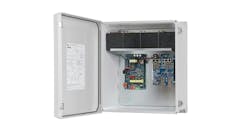Video surveillance is one of the most dynamic areas of electronic security. Its growth can be attributed to several factors, technological and sociological.
Early video equipment (CCTV) was expensive, fragile, involved high and dangerous voltages and often was unable to produce images of acceptable quality. Over the years, technology advanced from vacuum tubes and analog signal processing to IP, the cloud and high-definition (HD) digital processing.
The increased capabilities of HD digital signal processing also contributed to the growth of video surveillance. Now, modern video surveillance systems are integrated into security, access control and public-safety systems.
If you have any background in using low-voltage power supplies for electric strikes, many of the same power supplies can be used for cameras.
Power supply designs range from simple wall wart types to enclosed versions that use individual overload-protected outputs for each camera. Individual outputs permit other cameras to continue to operate if an issue develops with a specific camera.
Battery backup in a power supply also is helpful, so cameras will continue to operate when power is interrupted. Of course, the rest of the equipment in your system must be equipped with backup power, too. For example, the video recorder requires backup power to record and save video footage.
Much video equipment has transitioned to IP, which uses Ethernet network cabling. As a result, Power over Ethernet (PoE) continues to gain in popularity. Earlier versions of PoE had constraints and power limitations, but current versions are easy to deploy and are designed to operate larger loads.
The specifications for a particular camera or recorder will provide everything necessary to know about power and infrastructure requirements for your cameras, recorders and interface equipment.
For my own new projects, I’ve moved away from coax cable, but a lot of systems out there were installed using coax, so it’s good to be prepared to repair a faulty coax connection.
Although the thinking is that larger systems are preferred, small projects were the ones that paid the salaries while we waited to land big jobs. If you have a small company, large projects can prevent you from rolling on your routine service work, which is how you win and keep accounts.
Also, residential video is a growing market that typically involves only one or a few cameras, which means you don’t have to take out a loan for the equipment and make the jobsite your second home.
In video, great images and rock-solid reliability are what it’s all about. The cost of the wire, the ease with which it’s connected and terminated, and the complexity and cost of your power supplies are critical to profit and high performance.
Altronix Q&A
We contacted Ronnie Pennington, Altronix director of sales for the Americas, to find out how the video power-supply industry was trending.
Locksmith Ledger: How has PoE affected the power supply?
Ronnie Pennington: PoE is a method of deploying power. Traditionally, it’s thought of as the standard of powering IP cameras in our industry. What we have done is harnessed the traditional power used for video surveillance to provide power for access control systems by creating a power supply that uses the same power source an IP camera would use to power access control panels and devices.
LL: What’s the difference between a PoE power supply and a traditional power supply?
Pennington: The power source. Traditional access control power supplies use 115VAC/220VAC as a power source. The [Altronix] Tango uses PoE as a power source, the same power source being used with most IP surveillance cameras today.
I assume that most security dealers’ projects range from four cameras for DVR-based systems to much larger scale projects using NVRs [network video recorders] and the cloud. Many projects consist of video surveillance and access control integrated together. With the use of PoE to power IP cameras, that same power source can be used to power the access control systems as well. This method of deployment allows for the installer to cut down on materials and labor costs associated with having to install traditional access control power supplies.
LL: Does the transition from coax cable to Cat5 for video mean a replacement of the cable infrastructure?
Pennington: No. In many cases, integrators are using adapters, such as our eBridge series, to allow for IP video and PoE to be transmitted over coax without the need to rip and replace the legacy cabling.
Coax still might be used with analog systems that use HD analog cameras. However, we see the newer HD cameras being installed on legacy coax where the customer isn’t looking for a lot of bells and whistles. Analog cameras don’t deliver the analytics an IP camera provides. That’s why many customers make the switch to IP.
LL: Briefly, what is 4PPoE (802.3bt), and for what scale video projects does it become cost-effective?
Pennington: In September 2019, IEEE ratified the 802.3bt standard. The standard introduced four classes of PoE, classes 5-8. This allowed a PoE power source to provide up to 90 watts of PoE power to a device. These devices typically consume 51 or 71 watts. Traditional PoE, also known as PoE and PoE+, only uses two pairs of the four-pair category cable. 802.3bt uses all four pairs (4PPoE) of the cable to provide sufficient power to devices that are power-hungry. These devices include Pan Tilt Zoom (PTZ) cameras that have heaters and blowers, infrared illuminators and now power supplies, such as the Altronix Tango1B.
LL: With Tango, does reduced redundancy result in less reliability?
Pennington: There is actually more redundancy with Tango than with traditional power supplies. The Tango1B itself has a Lithium Iron Phosphate (LiFePO4) battery-charging circuit that backs up 12VDC and 24VDC with a single battery. In addition, the Netway1, 4 or 8BT power source is capable of battery backup, not to mention the UPS backup that typically is associated with rack-mounted networking equipment.
LL: What are your most popular “conventional” video power supplies?
Pennington: Our Netway Spectrum series of outdoor-hardened switches has become extremely popular with the outdoor surveillance market, as have our fiber media converters that provide PoE power. Our midspan/injectors continue to be a staple in video surveillance systems.
LL: What tech support do you provide?
Pennington: Our technical-support department is second to none and works with customers who require additional assistance setting up product. Most of our networking products have our LINQ technology built in. LINQ technology allows the integrators to easily set up equipment through self-help instructions on each page, and 95% of the time, installers are able to set up a system without any additional help. No tech training is required to deploy our products.
More info: www.altronix.com
Tim O’Leary is an experienced security consultant and a regular contributor to Locksmith Ledger.
Optiview Power Supplies
Most low-voltage distributors carry a variety of security, access control, life-safety and video products. Optiview specializes in video.
We contacted Georgia Fischel, director of marketing at Optiview, about the company’s power supplies for video surveillance. Here’s her response:
Optiview has provided power supplies for the CCTV industry for more than 20 years.
All coax-based cameras, whether they’re standard or high definition (HD) over coax, require a power supply. (We refer to them as power boxes.) We recommend installing the power supply in the same location as your recorder. From the recorder to the camera, you would use RG59 Siamese wire, which is RG59 coax with 18/2. Power supplies come in 12 volts DC (12VDC) or 24 volts AC (24VAC), are wall-mountable, can be plugged into a 110-volt wall outlet and convert power to 12VDC or 24VAC. From there, you wire all of your devices into the individually fused power distribution boards found inside your power supply.
Being individually fused means that a problem on one device won’t affect the other devices on the power distribution board. This allows the user to keep a majority of their system up and running, even if a specific device has trouble.
The majority of Optiview’s coax-based cameras use less than 250 milliamps and take a 12VDC power supply. Each output on the power distribution board inside the power box provides 1.1 amps of allowable power to the camera, and we can reach distances of 1,000 feet. For runs of more than 1,000 feet or for cameras that have larger power requirements for motors or intense night vision, you might have to consider 24VAC.
Fuse protection in power supplies has become more maintenance-free. Early versions had “single shot” glass fuses that often kept the customer down until the fuse was replaced. Newer power supplies use PTC fuses, which replaced the older glass “one shot” fuses with self-resetting fuses. Most of the time, the PTC fuse will “pop,” cool down and self-reset, and your device will come back online.
When it comes to IP-based cameras and PoE (Power over Ethernet), we only will discuss the principal standard of PoE at 48 volts (44.0-57.0V) for 802.3af.
Optiview IP cameras are PoE-enabled, and many get their power from the network video recorder (NVR) via a built-in PoE switch. This allows the installer to pull a single cable from the recorder to the camera and terminate the CAT5 or CAT6 to get video and power to and from the camera. This makes for a clean installation, and this wiring takes up less space than the typical Siamese wire that you see on HD-over-coax systems.
Standard PoE is rated for 100 meters (328 feet) for data and power transmission. It’s important to look at the overall power budget for your PoE device as well as your maximum per PoE port specifications to make sure you have sufficient power for all of your cameras. Our most popular IP camera uses less than 6 watts of power, while most of our PoE output devices have a max output per port of 15 watts.
When installing Pan Tilt Zoom (PTZ) cameras, cameras that have a longer range infrared (night vision) or heaters, power requirements of the camera might be as high as 60 watts. When this happens, you can use a PoE injector. This device is a single PoE power source that will pass network onto the recorder, while boosting power to the camera.
Some of our latest NVRs have a feature called ePoE. This takes away the distance limitation of 328 feet, but the PoE port being used must be an ePoE port, often indicated by green port numbers, and the camera also must support ePoE. Also, it must be a single CAT5/CAT6 cable connecting the NVR to the camera. You can’t have any splices, punchdowns or other breaks in the line.
More info: www.optiviewusa.com
Tim O'Leary
Tim O'Leary is a security consultant, trainer and technician who has also been writing articles on all areas of locksmithing & physical security for many years.






